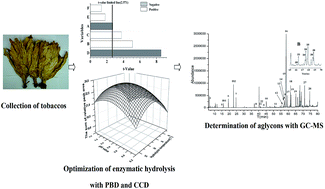To evaluate the glycoconjugated aroma compounds of three cultivars of tobacco, an enzymatic hydrolysis method followed by gas chromatography-mass spectroscopy (GC-MS) was successfully established using a series optimization approach. In the first step, two hydrolytic enzymes were compared and β-glucosidase was chosen. Then, the critical variables that affect the concentration of aglycons were searched by Plackett–Burman design (PBD) and further optimized by central composite design (CCD) of response surface methodology. The optimum conditions were: 60 h for hydrolysis time, 36.8 °C for hydrolysis temperature, 5.6 for pH, 2.1 mL for solvent volume, 2 mg mL−1 for β-glucosidase concentration and 200 rpm for agitation speed. Under the optimized experimental conditions, this method gave a satisfactory precision and linearity with relative standard deviation (RSD) less than 20% and Pearson correlation coefficients greater than 0.99. Finally, the proposed method was successfully employed to analyze flue-cured tobacco (FCT), sun-cured tobacco (SCT) and oriental tobacco (OT). Most of the aglycons were significantly different in the three cultivars and the corresponding characteristic components were discussed in detail.

